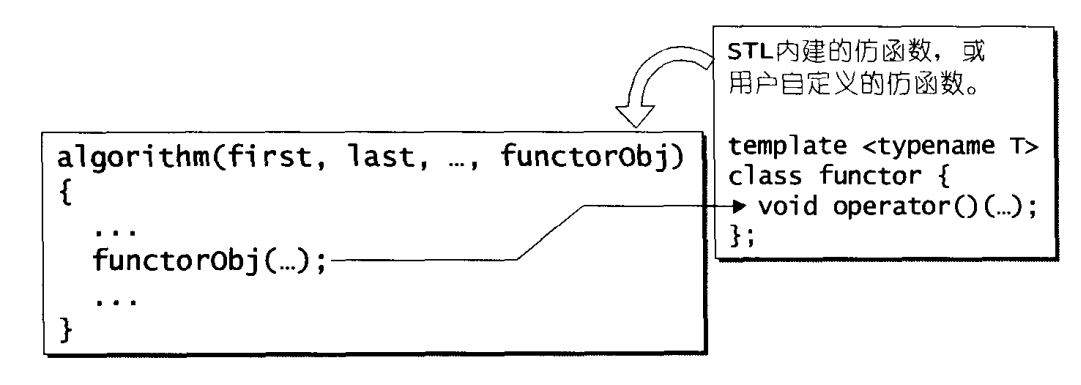第7章:仿函数
仿函数概述
仿函数也叫作函数对象,是一种具有函数特质的对象,调用者可以像函数一样地调用这些对象,被调用者则以对象所定义的function call operator扮演函数的实质角色。就实现观点而言,仿函数其实上就是一个“行为类似函数”的对象。为了“行为类似函数”,其类别定义中必须自定义function call 运算子(operator())。STL中仿函数代替函数指针的原因在于函数指针不能满足STL对抽象性的要求,也不能满足软件积木的要求,函数指针无法与STL其他组件搭配。
STL仿函数与STL算法之间的关系:

STL仿函数的分类,若以操作数的个数划分,可以分为一元和二元仿函数;若以功能划分,可以分为算术运算(Arithmetic)、关系运算(Rational)、逻辑运算(Logical)三大类。其头文件为<functional>。
STL仿函数应该有能力被函数适配器修饰,就像积木一样串接,然而,为了拥有配接能力,每个仿函数都必须定义自己的associative types(主要用来表示函数参数类型和返回值类型),就想迭代器如果要融入整个STL大家庭,也必须按照规定定义自己的5个相应的类型一样,这些assocaiative type是为了让配接器可以取得仿函数的某些信息,当然,这些associative type都只是一些typedef,所有必要操作在编译器就全部完成了,对程序的执行效率没有任何影响,不会带来额外的负担。
为了方便起见<stl_functional.h>定义了两个类classes,分别代表一元仿函数和二元仿函数。
unary_function用来呈现一元函数的参数型别和返回值型别。
//STL规定,每一个Adaptable Unary Function都应继承此类别
template <class Arg, class Result>
struct unary_function {
typedef Arg argument_type;
typedef Result result_type;
};
binary_function用来呈现二元函数的第一参数型别、第二参数型别及返回值型别。
//STL规定,每一个Adaptable Binary Function都应继承此类别
template <class Arg1, class Arg2, class Result>
struct binary_function {
typedef Arg1 first_argument_type;
typedef Arg2 second_argument_type;
typedef Result result_type;
};
算术类仿函数
STL内建算术类仿函数:加法:plus<T>,减法:minus<T>,乘法:multiplies<T>,除法:divides<T>,取模:modulus<T>,取反:negate<T>。
template <class T>
struct plus : public binary_function<T,T,T> {
T operator()(const T& x, const T& y) const { return x + y; }
};
template <class T>
struct minus : public binary_function<T,T,T> {
T operator()(const T& x, const T& y) const { return x - y; }
};
template <class T>
struct multiplies : public binary_function<T,T,T> {
T operator()(const T& x, const T& y) const { return x * y; }
};
template <class T>
struct divides : public binary_function<T,T,T> {
T operator()(const T& x, const T& y) const { return x / y; }
};
template <class T>
struct modulus : public binary_function<T,T,T>
{
T operator()(const T& x, const T& y) const { return x % y; }
};
template <class T>
struct negate : public unary_function<T,T>
{
T operator()(const T& x) const { return -x; }
};
测试程序:
#include <iostream>
#include <functional>
using namespace std;
int main() {
// 产生仿函数实体
plus<int> plusobj;
minus<int> minusobj;
multiplies<int> multipliesobj;
divides<int> dividesobj;
modulus<int> modulusobj;
negate<int> negateobj;
// 使用对象完成函数功能
cout << plusobj(3, 5) << endl; //8
cout << minusobj(3, 5) << endl; //-2
cout << multipliesobj(3, 5) << endl; //15
cout << dividesobj(3, 5) << endl; //0
cout << modulusobj(3, 5) << endl; //3
cout << negateobj(3) << endl; //-3
// 直接使用仿函数的临时对象完成函数功能
cout << plus<int>()(3, 5) << endl;
cout << minus<int>()(3, 5) << endl;
cout << multiplies<int>()(3, 5) << endl;
cout << divides<int>()(3, 5) << endl;
cout << modulus<int>()(3, 5) << endl;
cout << negate<int>()(3) << endl;
return 0;
}
关系运算类仿函数
STL内建关系类仿函数:等于:equal_to<T>,不等于:not_equal_to<T>,大于:greater<T>,大于等于:greater_equal<T>,小于:less<T>,小于等于:less_equal<T>。
template <class T>
struct equal_to : public binary_function<T,T,bool>
{
bool operator()(const T& x, const T& y) const { return x == y; }
};
template <class T>
struct not_equal_to : public binary_function<T,T,bool>
{
bool operator()(const T& x, const T& y) const { return x != y; }
};
template <class T>
struct greater : public binary_function<T,T,bool>
{
bool operator()(const T& x, const T& y) const { return x > y; }
};
template <class T>
struct less : public binary_function<T,T,bool>
{
bool operator()(const T& x, const T& y) const { return x < y; }
};
template <class T>
struct greater_equal : public binary_function<T,T,bool>
{
bool operator()(const T& x, const T& y) const { return x >= y; }
};
template <class T>
struct less_equal : public binary_function<T,T,bool>
{
bool operator()(const T& x, const T& y) const { return x <= y; }
};
测试程序:
#include <iostream>
#include <functional>
using namespace std;
int main() {
// 产生仿函数实体
equal_to<int> equal_to_obj;
not_equal_to<int> not_equal_to_obj;
greater<int> greater_obj;
greater_equal<int> greater_equal_obj;
less<int> less_obj;
less_equal<int> less_equal_obj;
// 使用对象完成函数功能
cout << equal_to_obj(3, 5) << endl; //0
cout << not_equal_to_obj(3, 5) << endl; //1
cout << greater_obj(3, 5) << endl; //0
cout << greater_equal_obj(3, 5) << endl; //0
cout << less_obj(3, 5) << endl; //1
cout << less_equal_obj(3, 5) << endl; //1
// 直接使用仿函数的临时对象完成函数功能
cout << equal_to<int>()(3, 5) << endl;
cout << not_equal_to<int>()(3, 5) << endl;
cout << greater<int>()(3, 5) << endl;
cout << greater_equal<int>()(3, 5) << endl;
cout << less<int>()(3, 5) << endl;
cout << less_equal<int>()(3, 5) << endl;
return 0;
}
逻辑运算类仿函数
STL内建逻辑类仿函数:逻辑运算And:logical_and<T>,逻辑运算Or:logical_or<T>,逻辑运算Not:logical_not<T>。
template <class T>
struct logical_and : public binary_function<T,T,bool>
{
bool operator()(const T& x, const T& y) const { return x && y; }
};
template <class T>
struct logical_or : public binary_function<T,T,bool>
{
bool operator()(const T& x, const T& y) const { return x || y; }
};
template <class T>
struct logical_not : public unary_function<T,bool>
{
bool operator()(const T& x) const { return !x; }
};
测试程序:
#include <iostream>
#include <functional>
using namespace std;
int main() {
// 产生仿函数实体
logical_and<int> and_obj;
logical_or<int> or_obj;
logical_not<int> not_obj;
// 使用对象完成函数功能
cout << and_obj(true, true) << endl; //1
cout << or_obj(true, false) << endl; //1
cout << not_obj(true) << endl; //0
// 直接使用仿函数的临时对象完成函数功能
cout << logical_and<int>()(true, true) << endl;
cout << logical_or<int>()(true, false) << endl;
cout << logical_not<int>()(true) << endl;
return 0;
}
证同、选择、投射
以下介绍的仿函数,都只是将其参数原封不动地传回。其中某些仿函数对传回的参数有刻意的选择,或者刻意的忽略。
// 证同函数,任何函数经过后不会改变,用于set rb_tree keyOfValue op
// identity is an extensions: it is not part of the standard.
template <class _Tp>
struct _Identity : public unary_function<_Tp,_Tp> {
const _Tp& operator()(const _Tp& __x) const { return __x; }
};
template <class _Tp> struct identity : public _Identity<_Tp> {};
// 选择函数,返回pair第一元素,用于map rb_tree keyOfValue op
// select1st and select2nd are extensions: they are not part of the standard.
template <class _Pair>
struct _Select1st : public unary_function<_Pair, typename _Pair::first_type> {
const typename _Pair::first_type& operator()(const _Pair& __x) const {
return __x.first;
}
};
// 选择函数,返回pair第二元素
template <class _Pair>
struct _Select2nd : public unary_function<_Pair, typename _Pair::second_type>
{
const typename _Pair::second_type& operator()(const _Pair& __x) const {
return __x.second;
}
};
template <class _Pair> struct select1st : public _Select1st<_Pair> {};
template <class _Pair> struct select2nd : public _Select2nd<_Pair> {};
// 传回一个忽略另一个
// project1st and project2nd are extensions: they are not part of the standard
template <class _Arg1, class _Arg2>
struct _Project1st : public binary_function<_Arg1, _Arg2, _Arg1> {
_Arg1 operator()(const _Arg1& __x, const _Arg2&) const { return __x; }
};
template <class _Arg1, class _Arg2>
struct _Project2nd : public binary_function<_Arg1, _Arg2, _Arg2> {
_Arg2 operator()(const _Arg1&, const _Arg2& __y) const { return __y; }
};
template <class _Arg1, class _Arg2>
struct project1st : public _Project1st<_Arg1, _Arg2> {};
template <class _Arg1, class _Arg2>
struct project2nd : public _Project2nd<_Arg1, _Arg2> {};
